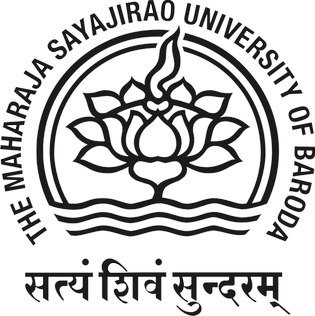
Maharaja Sayajirao University of Baroda, formerly Baroda College, is a public university in the city of Vadodara, Gujarat, India. Originally established as a college in 1881, it became a university in 1949 after India's independence. It was later renamed after its benefactor Maharaja Sayajirao Gaekwad III, the former ruler of Baroda State.

Ghulam Mohammed Sheikh is a painter, poet and art critic from Gujarat, India. He was awarded the Padma Shri in 1983 and Padmabhushan in 2014 for his contribution in field of art.
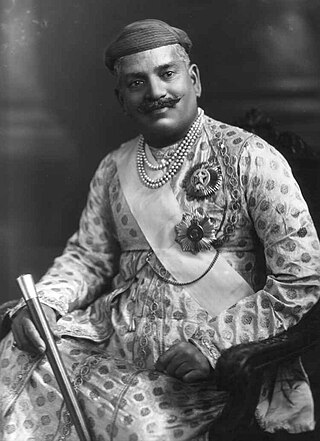
Sayajirao Gaekwad III was the Maharaja of Baroda State from 1875 to 1939, and is remembered for reforming much of his state during his rule. He belonged to the royal Gaekwad dynasty of the Marathas which ruled parts of present-day Gujarat.
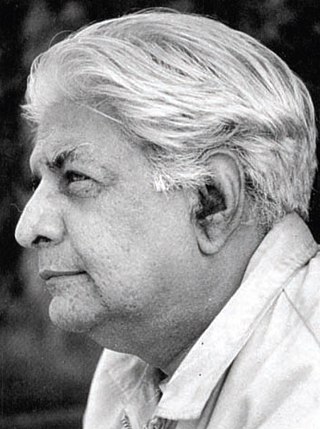
Narayan Shridhar Bendre was a 20th-century Indian artist and one of the founder members of Baroda Group Narayan Shridhar Bendre was born in Indore. He made a name for himself as a landscape artist. In 1992 he was awarded the Padma Bhushan.

The Baroda Museum & Picture Gallery is an archeological and natural history museum in Vadodara, Gujarat, India. It was built in 1894 on the lines of the Victoria & Albert Museum and the Science Museum of London.
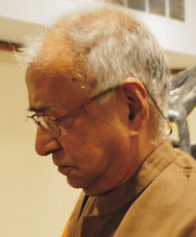
Kalpathi Ganpathi "K.G." Subramanyan was an Indian artist. He was awarded the Padma Vibhushan in 2012.
Kalal Laxma Goud is an Indian painter, printmaker and draughtsman. He works in variety of mediums including etching, gouache, pastel, sculpture, and glass painting. He is best known for his early drawings that depict eroticism in a rural context, and also for the originality and quality of his etchings and aquatints.
Jyotindra Manshankar Bhatt, better known as Jyoti Bhatt, is an Indian artist best known for his modernist work in painting and printmaking and also his photographic documentation of rural Indian culture. He studied painting under N. S. Bendre and K.G. Subramanyan at the Faculty of Fine Arts, Maharaja Sayajirao University (M.S.U.), Baroda. Later he studied fresco and mural painting at Banasthali Vidyapith in Rajasthan, and in the early 1960s went on to study at the Academia di Belle Arti in Naples, Italy, as well the Pratt Institute in New York. He was awarded the Padma Shri in 2019 and elected as a Fellow of the Lalit Kala Akademi in 2022.
Ranjitsinhrao Gaekwad was an Indian politician.

Thota Vaikuntam is an Indian painter. His paintings capture simple lifestyle of villagers like the paddy fields, toddy pots on shoulders of men, the household chores, temple rituals etc. His drawings range from stark charcoal on paper, transparent washes and pencil drawings.

Baroda State was kingdom and later princely state in present-day Gujarat, ruled by the Gaekwad dynasty of the Maratha Confederacy from its formation in 1721 until its accession to the newly formed Dominion of India in 1949. With the city of Baroda (Vadodara) as its capital, during the British Raj its relations with the British were managed by the Baroda Residency. The revenue of the state in 1901 was Rs. 13,661,000. Baroda formally acceded to the Dominion of India, on 1 May 1949, before which an interim government was formed in the state.
Shanti Dave is an Indian painter and sculptor, considered by many as one of the major Indian artists of the twentieth century. He is a former member of the Lalit Kala Akademi and the Sahitya Kala Parishad. The Government of India awarded him the fourth highest Indian civilian honour of Padma Shri in 1985.
Markand Jashbhai Bhatt was an Indian Gujarati theatre actor and director. Born and studied in Vadodara, he taught theatre for more than thirty years at M. S. University. He acted in and directed several Gujarati plays.
The GROUP 1890 exhibition was held from 20 to 29 October 1963 at Lalit Kala Akademi, Rabindra Bhavan in New Delhi, India. It was the only exhibition of the artist collective 'group 1890', hence the only existing record of the group's exhibition history in the 1960s contemporary art in India. The group was an entirely male association with 12 members which 'stood passionately and romantically for values of modernism that signaled change'. The members were Raghav Kaneria, M. Reddeppa Naidu, Ambadas Khobragade, Rajesh Mehra, Gulam Mohammed Sheikh, Jagdish Swaminathan, Himmat Shah, Jeram Patel, S. G. Nikam, Eric Bowen, Jyoti Bhatt, and Balkrishna Patel. All of which participated in this inaugural exhibition.
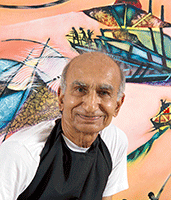
Jayant Parikh is an Indian modern contemporary artist, printmaker, and muralist. He is a student of N. S. Bendre, K. G. Subramanyan and Sankho Chaudhuri. He lives and works in Vadodara, India.
The Baroda Group refers to the artists involved with the Faculty of Fine Arts at Maharaja Sayajirao University of Baroda, now known as Vadodara in Gujarat state of India. An experimental art school that drew artists of a variety of backgrounds, the Baroda Group offered an alternative to the nationalism associated with Santiniketan and the Bengal School.

Jyotsna Jyoti Bhatt was an Indian ceramist and potter. She first studied at and then for forty years taught at the Maharaja Sayajirao University of Baroda.
Rekha Rodwittiya is a contemporary Indian artist associated with the Baroda School. She is known for her allegorical and metaphoric narrative paintings depicted through the style of surrealism and magical realism. She conducts an art studio in Vadodara called The Collective Studio, jointly with her husband and artist Surendran Nair.









